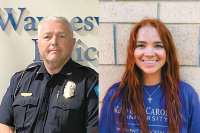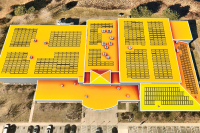A funeral story of necessity and pragmatism
By Dawn Gilchrist-Young
This is an Appalachian story because it is about resourceful people taking care of their own with little trust in institutions or reference to societal expectations. It is also an Appalachian story because it is about people with no money circumventing the status quo and experiencing equal measures of grace and awkwardness. But it is a universal story because it is about preparing a dead human body that you have loved, in this case the body of my aunt, Frances Barbery, in this case at home and with our own hands.
What we did was at Aunt Fran’s request, made possible through the help of a family friend, Julia Hunt, who was Fran’s hospice volunteer and home funeral guide. What we did was the difference, for my family, in incurring debt and remaining solvent, and in saying an intimate good-bye in a language we all understand, as opposed to saying good-bye in the mortuary chapel of kind professionals.
Other than my maternal grandmother, Aunt Fran was the poorest person I have ever loved. Her years of managing convenience stores, traveling with a carnival, selling plants in flea markets, and working in a resort laundry left her with no income in old age other than a social security check of $600 and change. She had cancers, and as they multiplied, she bought an insurance policy that would pay towards her funeral, but the primary expenses, she knew, would fall on my parents, who had taken care of her since she had become bedridden.
Because she had just buried her second husband a few months before, Aunt Fran was aware of the cost. She was congenitally independent, and so she was as delighted as a dying woman can be when Julia offered to guide my mother and Fran in the time leading to Fran’s dying and the death itself. Aunt Fran, my mother, my sisters, Julia, and I all agreed that we would prepare Aunt Fran’s corpse for cremation in the small bedroom where she spent her last months. Julia told us what to expect and that she would lead us through it, and my youngest sister, Camille, who rehabilitates wild animals and has a gift for treating the injured, agreed to be her right hand.
My part was to drive her body to the crematory. So that is how, on Jan. 15, 2009, I came to be driving Aunt Fran’s body from Euchella cove to a crematory in Asheville in my tiny car as part of a small convoy, a convoy that would fit seamlessly in a Flannery O’Connor story or a Jonathan Dayton film, a convoy that Fran would have enjoyed, maybe did enjoy, if any form of consciousness continues. Even though Aunt Fran was in a large cardboard box crowded in the back of a Prius, the box did offer her the dignity of plenty of room for her five foot frame, and she was wearing her favorite peach colored satin pajamas, a gift from one of my brothers.
Aunt Fran, her sense of humor developed from a lifetime’s practice of turning pain into laughter, would have certainly laughed at the absurdity of this journey, at my seat pushed all the way forward and my knees jacked up gracelessly on either side of the steering wheel. She would have laughed at my back seats folded down to slide in her last conveyance, at Camille in a contortionist’s position in the passenger seat, her cheek almost against the windshield in order to allow the hatch to shut. She would have laughed for joy that my mother’s back could begin to heal from long months of lifting and turning her to avoid bedsores. She would have laughed, too, when the entire parade — my mother, two of her siblings, four of her five children, a daughter-in-law, two grandchildren, and the amazing Julia — had to stop at the rest area on Balsam for a bathroom break for the grandchildren and to try to adjust the placement of Fran’s box to prevent permanent neck injury to Camille, already worn from helping to handle Aunt Fran’s increasingly incapacitated form that trapped her still lucid mind.
It was our knowledge of Fran’s mind that allowed us to do what we were doing on that frigid January morning, and that had allowed us to do what we had done since her death two mornings before. Julia’s instructions to my mother and Camille had been to call her as soon as Fran died. To properly begin the in-home process of preparing the body, certain protocols had to be followed. My sister, Regina, and I were also on hand to begin, although we mostly watched as the beautiful as well as unpleasant aspects of preparation ensued. The reality, and the reason this will not be chosen as a last ritual by many, is the obvious: the body is organic matter. Its bowels have to be emptied, its crevices cleaned, and its limbs arranged decently before rigor mortis sets in. The cold weather was a blessing. With the bedroom windows open and frigid air helping to slow the decomposition that begins when cells are no longer replaced, Camille and Julia, with Mom, Regina and I attending, proceeded to wash Aunt Fran with her favorite soap, shampoo her thinned strands of white hair, and powder her quiet body.
Fran’s humor had always leaned towards the earthy, and the washing and powdering recalled her stories and jokes. Bathing her arms and legs showed us her tan lines, retained even in January from a lifetime of gardening, and recalled for us her loves and passions. Bathing her ears showed us her many piercings, and reminded us, for her generation, of her unconventional approach to beauty. Bathing her contorted hands reminded us of the terrible pain of her rheumatoid arthritis, the perseverance and determination she exhibited in doing for herself until she could no longer do. Bathing her feet and applying her scant makeup recalled her concern, until the very last moment, that she always be presentable, if not pretty. And when it was finished, when she was wearing those satin pajamas and her hands were folded in the classic pose of repose, she was pretty.
When friends and family came the following day to pay respects, no one exclaimed with surprise that Fran “looked so natural” because she was in the bed where she had slept when they visited her over the past weeks, because she looked as she had when they last spoke with her. This was the Fran who taught us in those hours we prepared and transported her body that there is no better way to recognize the sacred in life than to love the body even after it dies.
And so this is an Appalachian story about pride, about my aunt’s pride, in life and death, that prevented her from asking for help from institutions or welfare. But it is also a universal story, and it is about humility. Because one individual was willing to ask friends and family for help, her humility taught all those involved about the sanctity and dignity that are possible even in death.
(Julia Hunt’s experience with her own mother’s home funeral moved her to seek further training with Center for End of Life Transitions, a non-profit project that offers assistance, comfort, and support to all faiths with home funeral education and guidance as well as end of life documentation workshops. For more information, contact Caroline Yongue at 828.676.9806 or at This email address is being protected from spambots. You need JavaScript enabled to view it.. Further, a Web site, now currently under construction, may be found at www.centerforendoflifetransitions.org.)





